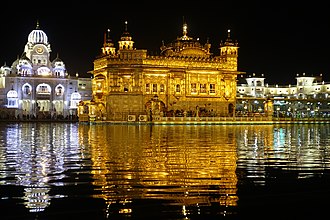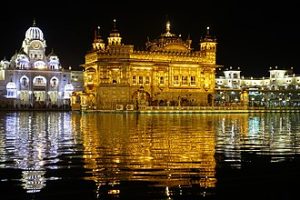
Sikhs Blocked on Instagram and Facebook
- By WRN Editorial Staff --
- 03 Jul 2020 --

Own work, CC BY-SA 4.0
WRN: Recently it was revealed that the hashtag #sikh was blocked on Facebook and Instagram. How did this happen, and how did this affect the Sikh community?
US: How this happened is a question that needs to be answered by Facebook, the parent company of Instagram. Like many communities, Sikhs use social media for personal and/or professional communication and/or marketing needs. It is an integral method of communication and relating to one another.
WRN: Did the Sikh community receive an apology or an acknowledgment that an injustice had occurred? If so, who said it and what was said?
US: There is an apology but without any explanation. That is unacceptable. It also deflects responsibility. The United Sikhs advocacy team has reached out to Facebook legal counsel with a letter of intent asking these questions. We are pursuing this communication to understand what happened, how it happened and what has been done by Facebook to prevent this from happening again.
WRN: Have any changes occurred since the blockage that indicates to you it will not happen again?
US: We do not know why this happened; therefore, we do not know if any changes have been put in place to make sure this does not happen again. It is hard to fathom the hashtag #christian #jew or #muslim getting blocked. As such, it is imperative Facebook explain how this error occurred.
This was first reported widely and acknowledged by Instagram on June 3rd, which is very significant in the Sikh psyche and calendar. Sikhs around the globe commemorate the first week of June as a seminal event in modern history; this is the date in 1984 when the Indian state sent its security and armed forces into over 40 Gurudwaras (Sikh places of worship) in the Northwestern state of Punjab where the majority of Sikhs hail from.
This attack centered around the holiest of Sikh places of worship, Darbar Sahib in Amritsar. The entire state of Punjab was put under curfew and journalists were expelled. Thousands were arrested and killed during this invasion known as “Operation Bluestar.” The assault coincided with one of the most significant dates in the Sikh calendar, the martyrdom of Sixth Living Master of Sikhs, Guru Arjan Dev Jee in June 1606. Tens of thousands of pilgrims were visiting Gurudwaras across Punjab — especially Darbar Sahib, which was designed and constructed under his leadership.
The date for this attack in June 1984 was not a coincidence; it was chosen by design to inflict damage on the Sikh body-politic and spirit. It is equivalent to blocking #Jew during Holocaust Remembrance Week. It is unfathomable and inconceivable.
WRN: How prevalent is bigotry against Sikhs?
US: Sikhs are one of the most mis-identified and mis-represented communities around the globe. Their visible long hair and turbans amid global ignorance about faith-based traditions has created a wave of bigotry against Sikhs from East to West.
In the West, especially post 9/11, Sikhs have constantly been a target of bigotry and intolerance in schools, workplaces, streets and communities at large.
In the East, especially India, Sikhs have a complicated history of being celebrated for their community service and bravery along with being vilified for their political, human rights, and identity-based needs.
Almost every Sikh can share personal stories of how they have been targeted for their faith.
WRN: How is the religious climate in the United States compared to India and other countries?
US: Religious climates vary widely by country. In India there is widespread visual recognition of Sikhs. Most are generically aware who Sikhs are, but there is gross misrepresentation of their history and values. The vast majority of this is intentionally created by political powers through the history of independent India.
In the West, many nations have robust policies around religious freedom. The challenge arises from widespread ignorance and stereotypes of people of faith.
WRN: Where do Sikhs experience the most bigotry?
US: This is a complicated question. India would be at the top of the list, where the trouble is most deep-rooted. This is one nation where political forces are fully engaged in framing the Sikh narrative to their own whims and fancy for nationalistic and jingoistic gains.
WRN: What are some of the issues?
US: Sikhs find themselves in one of the most unenviable positions. They keep having to educate their neighbors around the globe about who they are and explain that they are from the nations and communities they reside in. Many Sikhs find themselves framed as a perpetual “Other.” They are a demographic minority in every nation. There is no nation who represents their rights on the global stage (UN, etc.)
WRN: What has the Sikh community done to resolve some of the issues?
US: Sikhs have engaged in many ways. One is to be hard-working, dedicated members of their communities. Sikhs have been active in interfaith partnerships. Many have created educational partnerships across different institutions. Others have started serving in political offices. Canada seems to have the most political engagement when it comes to Sikhs. In the United States, the first two Sikh mayors with turbans and beards happened within the last eight years, the first being the mayor of Charlottesville, Virginia in 2012. https://www.cvillepedia.org/Satyendra_Huja
Many Sikh civil rights, human rights, and educational organizations have been born out of this background. Few of the well-known Sikh organizations were created in the late 1990s and in the post 9/11 era in the United States.
United Sikhs began in 1999 with a group of Sikhs in the New York metropolitan area creating a resource to assist in the socio-economic development of immigrant communities in Queens Borough of New York City.
Today United Sikhs has grown into an international aid and advocacy-based NGO affiliated with the United Nations with chapters in North America, Asia and Europe, to pursue projects for the spiritual, social and economic empowerment of underprivileged and minority communities.
One key thing of note in this regard has been the decade-long efforts by United Sikhs to have Sikhs counted in the U.S. census. Amazingly, there are no official counts of Sikhs in the United States. Starting with Census 2020, Sikhs can write in “Sikh” in the race question of the census. This will be the first official attempt at counting Sikhs in the United States.
In 2015 United Sikhs worked with the NYC Department of Education and Mayor’s Office to create two lesson plans incorporating Sikhs in America as part of the 5th and 6th grade curriculum. The largest school district in the nation has social studies lessons educating students about Sikhs in America from a civil rights lens.
United Sikhs has been very active in offering relief services around the globe. We have been on relief missions in over 35 natural disasters around the globe. The latest focus has been on the Covid-19 pandemic. We have offered over 2.5 million meals from India to North America to vulnerable communities in need.
The Center for Faith and Opportunity Initiatives at Federal Emergency Management Agency (FEMA) recognized United Sikhs along with six other faith-based organizations for their early response to Covid-19 pandemic.
Some have tried to create media and creative outlets to create and own their Sikh narrative. This is where the highest need for this effort exists, but these efforts are still small in impact.
Sikhs have an amazingly short 500-year-old global story to tell. Ironically, they have been lacking in telling these stories. In large part this has to do with the fact that Sikhs have rarely experienced periods of calm and prosperity in their short history. Sikhs have faced many holocausts and massacres in their young history at the hands of colonizers, tyrants, democratically elected oppressors and indifferent political powers.
WRN: What kinds of efforts have other religious groups done to help resolve the issues?
There are other religious groups that have lent helping hands and support to Sikh community to elevate the messaging of tolerance, compassion and things faiths have in common. Sikhs have been an increasing presence at the World Parliament of Religions.
WRN: You mentioned that Sikhs provide free meals in many regions. How did this begin, and why do you do it?
US: There are many who have written about the tradition of Langar and its origins. This link provides one of the best and brief descriptions of this tradition — The Sikh Dining Tradition of Langar
It is inherent within our faith to provide for those less fortunate, those in need, those who are vulnerable, those who cannot provide for themselves, and those who cannot speak for themselves. Langar is an integral part of the Sikh tradition in which a nourishing vegetarian meal is provided to all in a Gurdwara (Sikh place of learning and worship), which entails pangat (sitting as equals on the floor partaking in a meal) prior to becoming sangat (worshipping and praising the almighty together in the Darbar Sahib — Prayer Hall). This revolutionary concept bridges any human-concocted divides such as education, career, sex, financial position, familial legacy, etc. by ensuring all sit equally and among one another on the floor as they partake in the same meal, together. This concept needed to be expanded as envisioned by our Gurus to our communities at large. We cannot claim to be nourished if our neighbors are hungry. We cannot claim to be well when our neighbors suffer economic or social injustice. Hence, United Sikhs embarked upon a mission to provide for our at-risk communities and those impacted during times of great strife and disaster. This is carrying out the principles of the Sikh faith with tangible action. To date we have provided millions of meals in line with our mission to uplift communities and to make them robust and empowered.
WRN: What are some common misconceptions about the Sikh religion?
US: Common misconceptions are that Sikhs are Hindus, Sikhs are Muslims, Sikhs came into existence to protect the Hindu majority in India during Islamic colonial rule ad Sikhs are great warriors. This might be true, but its basic origins and background is grossly misunderstood. The Sikh warrior tradition is deeply rooted in spiritual compassion and love. From this arises their long tradition to fight for injustice from a place of seeing the oneness of humanity.
WRN: What do you wish people knew about the Sikh religion?
US: That to be Sikh is to be a lifelong student of “Love and Kindness” immersed into the daily routines of life. The universal energy that permeates the entire universe is known to Sikhs as “Waheguru.” To see this energy in every speck of creation is the meditation of Sikhs. It is not easy to realize this, which is why the Sikh way of life is not a religion per se, but a path to follow and live by, to sing hymnal poems from the Guru Granth Sahib (words of Sikh Gurus and other spiritual saints from other traditions), to listen to hymns, to self-reflect, to serve humanity, to be selfless in your actions. To be in humble reverence of the creative energy of Waheguru at all times and merge with it is the ultimate desired goal.
WRN: Thank you for your time and assistance. What are the best websites and resources for people to use to find out more about Sikhs?


















